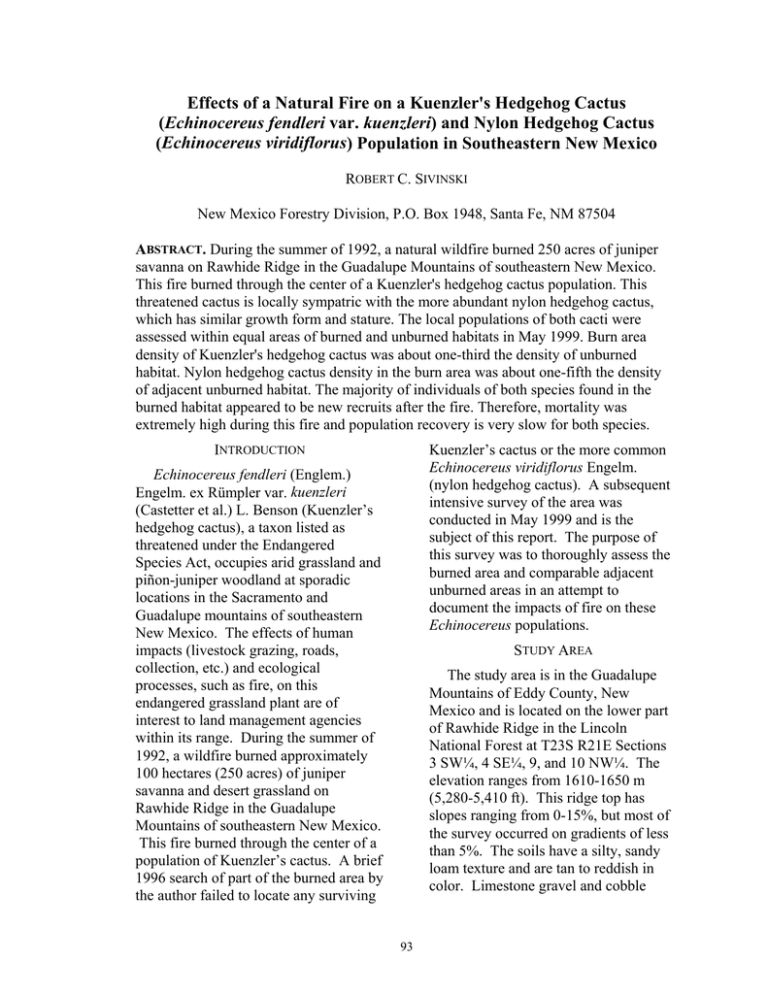Effects of a Natural Fire on a Kuenzler's Hedgehog Cactus
advertisement

Effects of a Natural Fire on a Kuenzler's Hedgehog Cactus (Echinocereus fendleri var. kuenzleri) and Nylon Hedgehog Cactus (Echinocereus viridiflorus) Population in Southeastern New Mexico ROBERT C. SIVINSKI New Mexico Forestry Division, P.O. Box 1948, Santa Fe, NM 87504 ABSTRACT. During the summer of 1992, a natural wildfire burned 250 acres of juniper savanna on Rawhide Ridge in the Guadalupe Mountains of southeastern New Mexico. This fire burned through the center of a Kuenzler's hedgehog cactus population. This threatened cactus is locally sympatric with the more abundant nylon hedgehog cactus, which has similar growth form and stature. The local populations of both cacti were assessed within equal areas of burned and unburned habitats in May 1999. Burn area density of Kuenzler's hedgehog cactus was about one-third the density of unburned habitat. Nylon hedgehog cactus density in the burn area was about one-fifth the density of adjacent unburned habitat. The majority of individuals of both species found in the burned habitat appeared to be new recruits after the fire. Therefore, mortality was extremely high during this fire and population recovery is very slow for both species. Kuenzler’s cactus or the more common Echinocereus viridiflorus Engelm. (nylon hedgehog cactus). A subsequent intensive survey of the area was conducted in May 1999 and is the subject of this report. The purpose of this survey was to thoroughly assess the burned area and comparable adjacent unburned areas in an attempt to document the impacts of fire on these Echinocereus populations. INTRODUCTION Echinocereus fendleri (Englem.) Engelm. ex Rümpler var. kuenzleri (Castetter et al.) L. Benson (Kuenzler’s hedgehog cactus), a taxon listed as threatened under the Endangered Species Act, occupies arid grassland and piñon-juniper woodland at sporadic locations in the Sacramento and Guadalupe mountains of southeastern New Mexico. The effects of human impacts (livestock grazing, roads, collection, etc.) and ecological processes, such as fire, on this endangered grassland plant are of interest to land management agencies within its range. During the summer of 1992, a wildfire burned approximately 100 hectares (250 acres) of juniper savanna and desert grassland on Rawhide Ridge in the Guadalupe Mountains of southeastern New Mexico. This fire burned through the center of a population of Kuenzler’s cactus. A brief 1996 search of part of the burned area by the author failed to locate any surviving STUDY AREA The study area is in the Guadalupe Mountains of Eddy County, New Mexico and is located on the lower part of Rawhide Ridge in the Lincoln National Forest at T23S R21E Sections 3 SW¼, 4 SE¼, 9, and 10 NW¼. The elevation ranges from 1610-1650 m (5,280-5,410 ft). This ridge top has slopes ranging from 0-15%, but most of the survey occurred on gradients of less than 5%. The soils have a silty, sandy loam texture and are tan to reddish in color. Limestone gravel and cobble 93 make up to approximately 50% cover and the barren limestone bedrock is frequently exposed at the surface. Chihuahuan fish-hook cactus (Sclerocactus uncinatus ssp. wrightii). METHODS Vegetation aspect is of a shrubby grassland and juniper savanna. Tree cover varies from 2-25% and is predominantly composed of one-seed juniper (Juniperus monosperma). A few piñon (Pinus edulis) and alligator juniper (Juniperus deppeana) contribute to the overstory. The relatively lowgrowing Pinchot’s juniper (Juniperus pinchotii) is nearly as abundant as J. monosperma and could be classified as either a small tree or large shrub. Other common shrub species include banana yucca (Yucca baccata), New Mexico agave (Agave parryi var. neomexicana), sacahuista (Nolina texana), sotol (Dasylirion leiophyllum), cholla (Cylindropuntia imbricata), prickly pear (Opuntia phaeacantha), squawbush (Rhus trilobata), algerita (Berberis haematocarpa), and Apache plume (Fallugia paradoxa). Grasses are the dominant ground cover (25-40%) and are mainly represented by curlyleaf muhly (Muhlenbergia setifolia), blue grama (Bouteloua gracilis) and black grama (Bouteloua eriopoda). Tabosa grass (Pleuraphis mutica) is localized, but densely covers silty swales in Karst depressions. Herbaceous species are fairly diverse, but comprise less than 5% of the ground cover. Common species include bladderpod (Physaria fendleri), globe mallow (Sphaeralcea leptophylla), vervain (Verbena perennis), and baby white aster (Chaetopappa ericoides). Species of low-growing, cylindrical cacti growing in this habitat include Kuenzler’s hedgehog cactus, nylon hedgehog cactus, pincushion cactus (Escobaria vivipera), Heyder’s pincushion (Mammillaria heyderi), and Field surveys were conducted on May 11-13, 1999, which coincides with the early blooming period for Kuenzler’s hedgehog in the Guadalupe Mountains. Surveyors included the author and three U.S. Forest Service employees. The first day was spent by a single observer establishing the perimeters of the burned and unburned study areas and flagging any observed Kuenzler’s hedgehog cacti. All four participants worked the following days. A total of 60 man hours were devoted to this field survey. Exactly one-half of this time was spent surveying the burned area and the other 30 hours surveying the adjacent unburned areas. Care was taken to ensure that the burned and unburned surveys were comparable. The same amount of time was spent in each treatment and roughly equal acreages were covered in the burned and unburned areas. Unburned area surveys were conducted on both sides of the burned area to determine if the original pre-fire population was continuous across the ridge top. Also, a few small areas of unburned habitat were located within the fire area. The survey was conducted by four men walking abreast at approximately 15 meter intervals. The outside man placed occasional strips of red flagging along his route so the inside man could keep a proper interval on the return trip across the study area. The most abundant and evenly distributed small cactus species in the area is a brownish red- flowered species of nylon hedgehog cactus (E. viridiflorus). This species is comparable 94 in burned and unburned treatments. to Kuenzler’s hedgehog in a fire impact study since they occur in the same grassy habitat and have approximately the same morphological stature. Therefore, all nylon hedgehog cacti were also counted in this study to corroborate the fire impact findings for Kuenzler’s hedgehog. Kuenzler’s hedgehog is distributed nearly throughout the entire study area. The area of greatest density is the unburned habitat just east of the fire line. Its greatest density within the burn area is also near the east fire line. Density begins to peter-out in the unburned area west of the fire line and only a single cactus was located in the eastern-most transect of the study area. Likewise, there are very few plants at the tip of the ridge in the eastern-most part of the study area. Therefore, it is reasonable to assume that the fire impacted a large portion (possibly half) of the Kuenzler’s hedgehog population on Rawhide Ridge and comparison of the burned and unburned areas is valid (Table 1). At the time of this survey (seven years postfire), there were two-thirds fewer Kuenzler’s hedgehog cacti in the burned area than in the comparable unburned habitat (43 vs. 110 respectively). The difference in nylon hedgehog densities was more dramatic with almost fourfifths fewer plants in the fire impacted area than the unburned area (74 vs. 342 respectively). RESULTS AND DISCUSSION Gross vegetation changes within the burned area (after seven years of recovery) were not especially dramatic. The line between burned and unburned habitats was often difficult to detect. Grass and forb cover were similar in both the burned and unburned treatments and most of the burned woody species (yucca, Pinchot’s juniper, squawbush, Apache plume, etc.) had sprouted from their root crowns. The most significant visual change in the burned area was the nearly complete elimination of sotol from the post-fire flora and the standing dead remains of one-seed juniper and cholla. Detection of young, non-flowering Kuenzler’s hedgehog cacti in grasscovered habitat is extraordinarily difficult. Only one non-flowering juvenile was located during the entire survey (burned area). All others cacti seen were adults and most of these had flowers or large flower buds. Since the juvenile fraction of the population could not be assessed by this field survey, it is reasonable to assume the proportionality of juvenile to adult individuals is similar Only two of the more than 20 Kuenzler’s hedgehog cacti seen by the author in the burned area appeared to be survivors of the 1992 wildfire. One was at the fire line (3 meters inside the burn area) where the fire intensity may have been low. It appeared to have been damaged because it had pupped three additional heads from the side of the TABLE 1. 1999 densities of Kuenzler’s hedgehog and nylon hedgehog cacti in equivalent areas of burned and unburned habitat on Rawhide Ridge, Guadalupe Mountains, NM. Nylon Hedgehog Kuenzler’s Hedgehog Unburned - East Side 70 116 Unburned - West Side 34 223 Unburned inclusions (within fire area) 6 3 Total within unburned habitat 110 342 Total within burned habitat 43 74 95 hedgehog cacti (74 and 43 respectively) in the burned area may be explained by the fact that the nylon hedgehog is a more abundant species and had established a larger soil seed bank for the germination of new plants in the post-fire habitat. plant facing the fire. The other survivor was within a large barren area of rock outcrop where it had escaped the flames. All other Kuenzler’s hedgehog cacti seen by the author within the burned area lacked the gray epidermis on the lower stem, which marks older cacti. Therefore, approximately 90% of Kuenzler’s hedgehog cacti seen in the fire-impacted area were probably less than seven years-old and had only recently reached reproductive age. Most cactus species of this type require at least four to five years to become large enough to flower and make fruit. These new individuals apparently germinated from the soil seed bank within a year or two after the fire. Seed dispersal from mature cacti in adjacent unburned habitat is also a possible source of these new individuals, but less likely, since dispersal over a distance is probably a slower process. CONSERVATION CONSIDERATIONS Fire appears to have an immediate and severe effect on Kuenzler’s hedgehog populations. These cacti usually grow in grassy areas and are frequently found within clumps of grass. This proximity to highly flammable fine fuels results in the death of most cacti when fire sweeps through the habitat. The impact of fire over the long-term is not so bleak. The Rawhide Ridge population of Kuenzler’s hedgehog was apparently large enough to establish a soil seed bank capable of immediately colonizing the post-fire habitat. Germination and establishment may have been enhanced by nutrients released from burned vegetation. Total recovery, however, appears to be a slow process. Seven years after the Rawhide Ridge Fire, the adult population within the burned area was rather spotty and significantly less numerous than in the adjacent unburned habitat. The soil seed bank in the burned area was probably depleted after the first flush of germinants and will probably need many years of reproductive success by new adults to become sufficient to colonize a subsequent fire. Population density and an uneven age structure will also take many more years to normalize to pre-fire levels. At least two more generations similar to the first flush of post-fire recruitment will be needed to bring this species back to pre-fire density. The majority of the approximately 60 Kuenzler’s hedgehog cacti seen by the author in the unburned area had gray lower stems and appeared relatively old. Since nearly all of the Kuenzler’s hedgehog cacti seen in the burned area were relatively young, it is reasonable to assume that mortality during the 1992 fire was almost complete. Severe mortality also occurred in the fireimpacted population of nylon hedgehog cactus. The dead remains of several nylon hedgehog cacti were still visible in 1996 and no live plants were seen during a brief walk through the burned area. Although relative age is difficult to determine for nylon hedgehog, the assumption that the majority of nylon hedgehog cacti in the burned area were less than seven years-old is probably also reasonable. The greater number of nylon hedgehog cacti than Kuenzler’s 96 (BLM-Roswell) while fighting the Rawhide Ridge fire in 1992. Prescribed fire is an important land management tool. Its use need not be eliminated from areas containing Kuenzler’s hedgehog populations, but its impact could be significantly reduced if two considerations are included in the prescription: 1. An entire population of Kuenzler’s hedgehog population should not be burned in any single prescribed fire event. The distribution of this plant is spotty and patch densities are usually very low (often less than five individuals). Low density patches may not have a sufficient soil seed bank to recover, and colonization of a particular patch of post-fire habitat may be entirely reliant upon seed dispersal from plants in adjacent unburned habitats. 2. Sufficient time between fire events should be allowed for the burned population to recover from the first fire and establish a soil seed bank capable of colonizing a subsequent burn. This is a very slow process and requires several generations to regain the pre-fire density of adult, seed-producing cacti. Therefore, fire frequency should not be less than 25 year intervals, and 50 year intervals may be a more prudent choice. This survey should be repeated in another 10-15 years to test the assumptions made in this report on the time period needed for post-fire recovery. Fire frequency prescriptions could be refined and adjusted when additional information is available. ACKNOWLEDGEMENTS This study was funded by the Lincoln National Forest. The field survey was assisted by the sharp eyes of Alex Camero, Sam Fragua, and Duane Ross. This population of Kuenzler’s hedgehog was initially discovered by Dan Baggao 97



